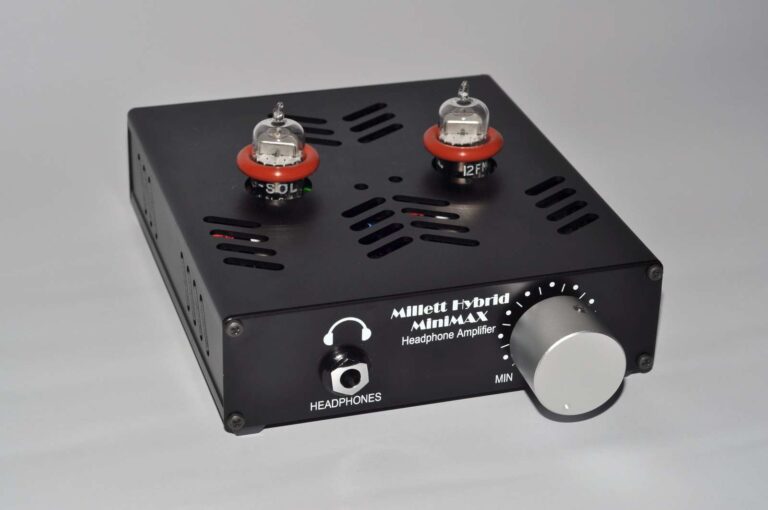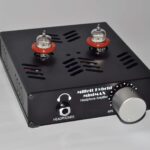Today, I am doing a walk-through of the assembly, testing, and evaluation of the Millett Hybrid MiniMAX Headphone Amplifier over the last 10 months. As of 2024, the OG version is priced at $320.
Disclaimer: This unit was purchased by me and I am giving my honest opinion as an owner. Headfonics is an independent website with no affiliate links or status. You can read more about this amplifier at the Beezar website.
Click here to read more about tube amplifiers that we have covered on Headfonics.
Note, that this article follows our latest scoring guidelines which you can read here.
The Millett Hybrid MiniMAX Headphone Amplifier is a refinement of Pete Millett’s original design, the MiniMAX, and is designed by Colin Toole, (cetoole).
You get a complete kit from Beezar, care of Tom Blanchard (tomb).
This is a hybrid headphone amplifier that marries vacuum tube gain and discrete solid-state amplification from bipolar junction transistors.
DIY Assembly
The complete MiniMAX Headphone Amplifier kit consists of the PCB and all transistors, resistors, diodes, LEDs, one pair of tubes, heat sinks, screws and screw mounts, jacks, potentiometer, enclosure, power supply, trimmer adjustment tool, digital multimeter.
Everything except heat shrink, wire, solder, and the iron. Delivered via Johnny Air Cargo. It was a heavy bugger.
It arrived in a big brown box containing four USPS boxes from Mouser, all properly labeled and sorted according to their arrangement on the schematic diagram. A fifth box from Triad carried the huge 120V power plug.
I properly matched the transistors before soldering them and adjusted them before the voltage regulator draw, ending with biasing the tubes for each of their voltage draws.
The case design does not allow modifying the transistor and power supply trimmers from the outside, only the tube bias, where holes are provided as you can see in the picture.
With ample preparation time, I finished matching transistors and populating the PCB in about six hours. Wiring took two hours, and assembly plus adjusting the trimmers, one hour.
I used a 12-square-inch medium-density fiberboard easily found at Daiso (P88) stores. The solder is a regular 60/40 flux core.
The iron I used was a NewStar 30-watt gun type that has a button to temporarily increase the power to 70 watts. I used a stainless steel pot scrubber (the meshy one) for cleaning the iron tip in between hits.
The wires were from Alexan Megamall. Solid 22 gauge silver plated copper wire served as jumpers on the PCB where required, and 15-strand 22 gauge SPC as signal wires.
While building this amplifier, I made sure that all parts were carefully and cleanly soldered onto the board. All the information you will ever need in building this amp is included in the documentation on the website. Last-minute additional info is included in the package you will receive.
Multiple gain options
There are three tube options for the MiniMAX:
- 12AE6
- 12FM6
- 12FK6
The 12AE6 is the high gain tube (12) that is suited for high-impedance headphones. They are the punchiest, most bassy, and overall badass slammin’ tubes.
The 12FM6 are in the middle with a gain of 10.
The 12FK6 has the lowest gain (7) but has the airiest presentation and reveals the most details. They are suited for low-impedance headphones.
Sound Impressions
Day 3
Just rolled into the 12AE6 tubes, having an amplification factor of 14 (actual value reduced by 2-3).
Suggested for high impedance cans (which I have none so far), these tubes indeed are “punchier” than the middle-ground 12FM6 (factor 10, actual <).
They don’t sound as smooth as the previous tubes, though. Give it a song with a lot going on in the lower registers, and you get chaos. For most electro-pop, these tubes make the bass downright enjoyable, if not overwhelming.
Not so noticeable for pre-loudness war songs, at least for me. What is noticeable generally is that the music seems to want to jump out and claw into your ears. At higher volume levels, it starts to get messy, but no loss of fidelity.
With the Grado HF2 (standard 32Ω impedance for Grados), I can’t listen to most music over the eleven-o-clock position. These are the high-gain tubes. Mean tubes. I think these would drive HD 600 or HD 650 300Ω headphones just fine.
These turned Alumigany into a mean girl. A little more burn-in and let’s see if these tubes clean up their messy acts.
Next week I will roll in the 12FK6
Some observations with the new 12AE6 tubes.
Upon powering on the MiniMAX, I test the tube bias using a digital multimeter, and the reading starts at about 25V and above. This value is high and is responsible for the quick heat-up of the tubes.
This is also the purpose of the relay-delay circuit on the PCB, because without it, if a headphone/speaker is plugged in while starting up, a nasty surge of some sort can blow the cans. This is why I only plug in headphones after about a minute, just to be safe.
I’ve tried using the old unbranded Koss cans while turning on the unit, and so far the relay-delay does its job well. As soon as I press the power button, there is no sound whatsoever.
No strong pops or anything, but just a little click after about 15 seconds, which is when the tubes start glowing. By the way, the relay-delay circuit used in the MiniMAX is a simplified version of AMB Labs’ epsilon12.
After five minutes the voltage per tube settles down to 12.80 and decreases slowly for about 30 minutes. Last night I remember setting these at 12.20. These tubes have been fired up only last night, so I’ll give them a few more days.
This is a good way of measuring if the tubes are properly burned in already. The faster the voltage settles, the better.
Day 5
I think the 12AE6 tubes are fully burned in, and now they’ve become too punchy for me. For a bassy can like the HF2 on some tracks it can get too warm.
Day 6
Bendix 12FK6 currently burning in.
I think these tubes are the ones for my Grado HF2 headphones. A tiebreaker between this and the FM will have to be done to determine the clear winner, although there is more air and that means better high-frequency extension. I love the sweetness these tubes give my Grados! Can you spell eargasm?
The AE6 tubes will be kept until I get myself a high-end Senn or other 250Ω headphones.
12FM6 for when I need a bass trip. Bass from the FK6 has significantly less impact than the AE6 but no doubt it’s still there, deep and tight.
Day 7
With the Audio-Technica ATH-ES7 (32 ohm) + 12FK6 tubes (gain 7) = eargasm!
The 12FK6 are the most revealing tubes for this amplifier. If the 12AE6 are unforgiving in terms of slam and dynamics, these are unforgiving in detail and extension. The background hum on tracks that have it is clearly heard, but it is dead silent for well-recorded/mastered/engineered albums.
Day 262
Took this bad boy out of the case for a spring cleaning of its guts. Clipped some extra long leads underneath, used MC cleaner to rub off leftover flux, and wiped clean with a microfiber cloth.
I tried using the stock Triad AC adaptor again (with a 60W 220V to 110V converter), but the VREG still doesn’t go higher than 24VDC (it should be 27VDC optimally) no matter how high I turn the trim pot. So that means I’m still stuck with my huge 4 amp 24VAC power “box”.
Millett Hybrid MiniMAX Headphone Amplifier Specifications
- Millett Hybrid circuit (Single-ended vacuum tube gain stage and solid-state output stage)
- Onboard, low-noise linear-regulated power supply
- Discrete transistors (BJT Diamond Buffer output stage)
- Relay-delay circuit for headphone protection
- Custom-machined case from Lansing Enclosures
- Nichicon Muse ES capacitors
- Vitamin Q paper in oil capacitors
- Wima film capacitors
- Vishay-Dale resistors
- Alps RK27 potentiometer
- Neutrik output jack



